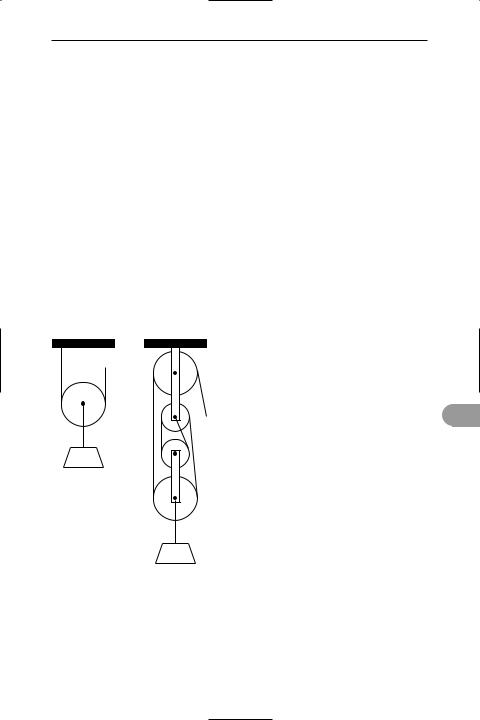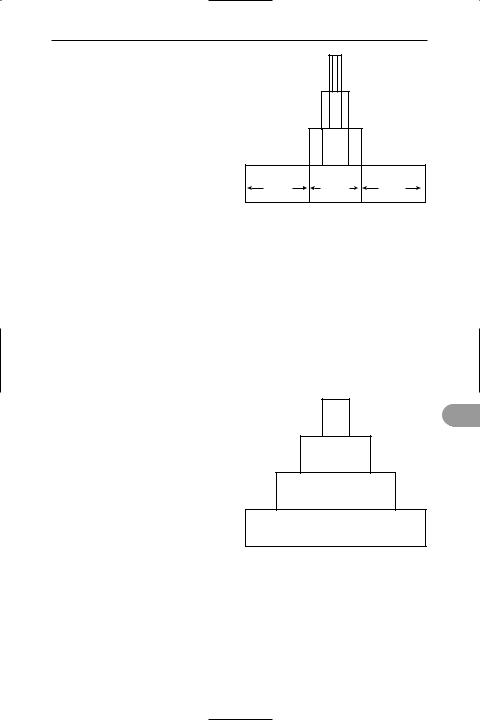
A Dictionary of Science
.pdf
protease |
666 |
zation does not occur. Examples of protandrous Ûowers are ivy and rosebay willowherb. Compare protogyny; homogamy. See also dichogamy. 2. The condition in some hermaphrodite or colonial invertebrates in which the male gonads or individuals are sexually mature before the female ones. Compare protogyny.
protease (peptidase; proteinase; proteolytic enzyme) Any enzyme that catalyses the hydrolysis of proteins into smaller *peptide fractions and amino acids, a process known as proteolysis. Examples are *pepsin and *trypsin. Several proteases, acting sequentially, are normally required for the complete digestion of a protein to its constituent amino acids.
protein Any of a large group of organic compounds found in all living organisms. Proteins comprise carbon, hydrogen, oxygen, and nitrogen and most also contain sulphur; molecular weights range from 6000 to several million. Protein molecules consist of one or several long chains (*polypeptides) of *amino acids linked in a characteristic sequence. This sequence is called the primary structure of the protein. These polypeptides may undergo coiling or pleating, the nature and extent of which is described as the secondary structure. The three-dimensional shape of the
pcoiled or pleated polypeptides is called the
tertiary structure. Quaternary structure speciÜes the structural relationship of the
component polypeptides.
Proteins may be broadly classiÜed into globular proteins and Übrous proteins. Globular proteins have compact rounded molecules and are usually water-soluble. Of prime importance are the *enzymes, proteins that catalyse biochemical reactions. Other globular proteins include the *antibodies, which combine with foreign substances in the body; the carrier proteins, such as *haemoglobin; the storage proteins (e.g. *casein in milk and *albumin in egg white), and certain hormones (e.g. *insulin). Fibrous proteins are gener-
ally insoluble in water and consist of long coiled strands or Ûat sheets, which confer strength and elasticity. In this category
are *keratin and *collagen. Actin and myosin are the principal Übrous proteins of muscle, the interaction of which brings
about muscle contraction. *Blood clotting involves the Übrous protein called Übrin.
When heated over 50°C or subjected to strong acids or alkalis, proteins lose their speciÜc tertiary structure and may form insoluble coagulates (e.g. egg white). This usually inactivates their biological properties.
protein blotting See western blotting.
protein engineering The techniques used to alter the structure of proteins (especially enzymes) in order to improve their use to humans. This involves artiÜcially modifying the DNA sequences that encode them so that, for example, new amino acids are inserted into existing proteins. Synthesized lengths of novel DNA can be used to produce new proteins by cells or other systems containing the necessary factors for *transcription and *translation. Alternatively, new proteins can be synthesized by solid state synthesis, in which polypeptide chains are assembled under the control of chemicals. One end of the chain is anchored to a solid support and the chemicals selectively determine which amino acids are added to the free end. The appropriate chemicals can be renewed during the process; when synthesized, the polypeptide is removed and puriÜed. Protein engineering is used to synthesize enzymes (socalled ‘designer enzymes’) used in biotechnology. The three-dimensional tertiary structure of proteins is crucially important for their function, and this can be investigated using computer-aided modelling.
proteinoid A protein-like substance formed by polymerization of amino acids under inorganic conditions, such as heating to over 140°C. In the 1970s it was discovered that proteinoids could also be formed by relatively mild heating (70°C) in the presence of certain inorganic catalysts (e.g. phosphoric acid). In water, proteinoids aggregate to form small round bodies called proteinoid microspheres, or ‘protocells’. These have certain attributes of living cells, such as a differentially permeable Ülmlike outer layer, the ability to swell and shrink due to osmotic movements of water, and the capability for

667 |
prothallus |
budding and binary Üssion. It has been proposed that such microspheres could have provided a suitable vehicle for the chemical components of life to evolve a primitive form of metabolism and pave the way for the emergence of the Ürst living cells.
protein sequencing The process of determining the amino-acid sequence of a protein or its component polypeptides. The technique most commonly used is Edman degradation (devised by Pehr Edman), in which the terminal amino-acid residues are removed sequentially and identiÜed chromatographically. Each step is automated and the whole process can now be performed by a single machine – the sequenator. Large polypeptides must be cleaved into smaller peptides before sequencing.
The results of this chemical sequencing can often be compared with the aminoacid sequence deduced by *DNA sequencing. The gene coding for the protein under investigation may be found by screening a *DNA library, for example by *Western blotting. However, the base sequence of the gene gives only the aminoacid sequence of the nascent protein, i.e. before post-translational modiÜcation. The sequence of the functional protein can only be found by chemical analysis.
protein synthesis The process by which living cells manufacture proteins from their constituent amino acids, in accordance with the genetic information carried in the DNA of the chromosomes. This information is encoded in messenger *RNA, which is transcribed from DNA in the nucleus of the cell (see genetic code; transcription): the sequence of amino acids in a particular protein is determined by the sequence of nucleotides in messenger RNA. At the ribosomes the information carried by messenger RNA is translated into the sequence of amino acids of the protein in the process of *translation.
proteolysis The enzymic splitting of proteins. See protease.
proteolytic enzyme See protease.
proteome The entire complement of proteins synthesized by a cell or organism
at a given time. This can be determined by analysing protein constituents of cell contents using such techniques as gel electrophoresis, high-throughput liquid chromatography, and mass spectroscopy, coupled with automated database searching to identify proteins. Unlike the genome, the proteome is constantly changing due to the inÛuence of intracellular and extracellular factors. See proteomics.
proteomics The study of the proteins synthesized by a particular cell or organism (see proteome). This vast and rapidly expanding Üeld is of fundamental signiÜcance to many areas of biology and medicine. It endeavours to determine what proteins a cell makes, how and when it makes them and in what quantities, how different proteins function, where they function, and how they interact with other cell components, including other proteins. Moreover, proteomics seeks to discover the internal and external factors that inÛuence the proteome, for example during development, disease, or ageing. See also transcriptomics.
Proterozoic The eon of geological time extending from the end of the *Archaean, about 2600 million years ago, to the start of the present eon (see phanerozoic),
about 570 million years ago. Life in the p early Proterozoic was dominated by bac-
teria, which Ûourished in shallow seas and muds. They depended on a wide variety of metabolic strategies, including photosynthesis, which were crucial in determining the composition of the earth’s atmosphere and oceans. The oldest eukaryotic fossils date from after the middle Proterozoic, about 1200 million years ago. These early protoctists are thought to have arisen through symbiotic associations of various prokaryotes (see endosymbiont theory), probably on several independent occasions.
prothallus A small Ûattened multicellular structure that represents the independent *gametophyte generation of clubmosses, horsetails, and ferns. In some of these plants a single prothallus bears both male and female sex organs. In others there are separate male and female prothalli.

prothrombin |
668 |
prothrombin (Factor II) One of the blood *clotting factors. It is the precursor of the enzyme thrombin, which catalyses the formation of the Übrin matrix of the blood clot. Prothrombin synthesis occurs in the liver and is dependent on adequate supplies of vitamin K. See also blood clotting.
Protista In some classiÜcations, a kingdom containing unicellular eukaryotes that cannot be classiÜed as animals, plants, or fungi. Originally proposed by Ernst *Haeckel in 1866 to include the algae, bacteria, fungi, and protozoa, it was later restricted Ürst to unicellular organisms, and then to protozoa, unicellular algae, and organisms then regarded as simple fungi. In most modern classiÜcations it has been replaced by the *Protoctista.
Protoctista A kingdom consisting of unicellular or simple multicellular organisms that possess nuclei and cannot be classiÜed as animals, plants, or fungi. Protoctists include the *protozoa, *algae, and *slime moulds. See also protista.
protogyny 1. The condition in which the female reproductive organs (carpels) of a Ûower mature before the male ones (stamens), thereby ensuring that self-
pfertilization does not occur. Examples of protogynous Ûowers are plantain and Ügwort. Compare protandry; homogamy. See also dichogamy. 2. The condition in hermaphrodite or colonial invertebrates in which the female gonads or individuals are sexually mature before the male ones.
Compare protandry.
proton An *elementary particle that is stable, bears a positive charge equal in
magnitude to that of the *electron, and has a mass of 1.672 614 × 10–27 kg, which is 1836.12 times that of the electron. The proton occurs in all atomic nuclei (the hydrogen nucleus consists of a single proton).
proton decay A process of the type
p → e+ + π0
where a proton decays into a positron and a pion, predicted to occur in *grand uniÜed theories (GUTs) because baryon number is no longer conserved. The life-
time depends on the theory used and is typically 1035 years, but a combination of GUTs and *supersymmetry gives a lifetime of about 1045 years. Considerable experimental effort has been spent in looking for proton decay, so far with no success.
protonic acid An *acid that forms positive hydrogen ions (or, strictly, oxonium ions) in aqueous solution. The term is used to distinguish ‘traditional’ acids from Lewis acids or from Lowry–Brønsted acids in nonaqueous solvents.
proton number See atomic number.
proto-oncogene See oncogene.
protoplasm The material comprising the living contents of a *cell, i.e. all the substances in a cell except large vacuoles and material recently ingested or to be excreted. The term is no longer used; the material of the cell is now referred to as the *nucleoplasm and the *cytoplasm.
protoplast (energid) The living unit of a cell, consisting of the nucleus and cytoplasm bounded by the plasma membrane. Protoplasts of bacterial and plant cells can be prepared by removing the cell wall; they are used to study the processes involved in cell metabolism and reproduction.
protostar See stellar evolution.
Prototheria A subclass of mammals – the monotremes – that lay large yolky eggs. It contains only the duckbilled platypus and the spiny anteater. After hatching, the young feed on milk from simple mammary glands inside a maternal abdominal pouch. In the anteater the eggs are also incubated in this pouch, while the platypus builds an underground nest. Adult monotremes have no true teeth. Their skeleton resembles that of a reptile, and although they are warm-blooded the body temperature is somewhat variable. They are believed to have originated at least 150 million years ago.
protozoa A group of unicellular or acellular, usually microscopic, organisms now classiÜed in various phyla of the kingdom *Protoctista. They were formerly regarded either as a phylum of simple animals or as members of the kingdom *Protista. They

669 |
pseudohalogens |
are very widely distributed in marine, freshwater, and moist terrestrial habitats; most protozoans are saprotrophs, but some are parasites, including the agents causing malaria (Plasmodium) and sleeping sickness (Trypanosoma), and a few contain chlorophyll and carry out photosynthesis, like plants. Protozoan cells may be Ûexible or rigid, with an outer *pellicle or protective test. In some (such as Paramecium and Trypanosoma) cilia or Ûagella (see undulipodium) are present for locomotion; others (such as *Amoeba) have *pseudopodia for movement and food capture. *Contractile vacuoles occur in freshwater protozoans. Reproduction is usually asexual, by binary *Üssion, but some protozoans undergo a form of sexual reproduction (see conjugation).
Prout’s hypothesis The hypothesis put forward by the British chemist William Prout (1785–1850) in 1815 that all atomic weights are integer multiples of the atomic weight of hydrogen and hence that all atoms are made out of hydrogen. Subsequent work on atomic weights in the 19th century showed that this hypothesis is incorrect (with chlorine having an atomic weight of 35.5 being a glaring example of this). The understanding of atomic structure that emerged in the 20th century, with atomic number being the number of protons in an atom and noninteger atomic weights being due to mixtures of isotopes, has vindicated the spirit of Prout’s hypothesis.
proventriculus 1. The anterior part of the stomach of a bird, where digestive enzymes are secreted. Food passes from the proventriculus to the *gizzard. 2. See gastric mill.
provirus The intermediate stage in the infection of a host cell by a virus, e.g. a *retrovirus, in which the viral genome is integrated into the host cell DNA, where it can undergo successive replications before being transcribed to form new RNA viruses. A provirus, notably that of *HIV, can remain dormant for long periods before being transcribed.
proximal Denoting the part of an organ that is nearest to the organ’s point of attachment. For example, the knuckles are
at the proximal end of the Üngers. Compare distal.
proximal convoluted tubule (Ürst convoluted tubule) The section of a
*nephron situated between Bowman’s capsule and the loop of Henle in the vertebrate kidney. Reabsorption of salt, water, and glucose from the *glomerular Ültrate occurs in this tubule; at the same time certain substances, including uric acid and drug metabolites, are actively transferred from the blood capillaries into the tubule. Both activities are facilitated by Ünger-like projections (see brush border) on the inner surface of the tubule, which increase its effective surface area.
prussic acid See hydrogen cyanide.
pseudoaromatic (antiaromatic) A compound that has a ring of atoms containing alternating double and single bonds, yet does not have the characteristic properties of *aromatic compounds. Such compounds do not obey the Hückel rule. Cyclooctatetraene (C8H8), for instance, has a ring of eight carbon atoms with conjugated double bonds, but the ring is not planar and the compound acts like an alkene, undergoing addition reactions. See also annulenes.
pseudocarp (false fruit) A fruit that in-  corporates, in addition to the ovary wall, p other parts of the Ûower, such as the *re-
corporates, in addition to the ovary wall, p other parts of the Ûower, such as the *re-
ceptacle. For example, the Ûeshy part of the strawberry is formed from the receptacle and the ‘pips’ on the surface are the true fruits. See also composite fruit; pome; sorosis; syconus.
pseudogene A sequence of nucleotides in DNA that resembles a functional gene but is not transcribed. Pseudogenes are thought to arise by duplication of an existing gene through unequal crossing-over during meiosis, with accompanying loss of the promoter or other Ûanking regions required for transcription. For example, the α- and β-globin gene clusters in humans contain several pseudogenes.
pseudohalogens A group of compounds, including cyanogen (CN)2 and thiocyanogen (SCN)2, that have some resemblance to the halogens. Thus, they form hydrogen acids (HCN and HSCN) and

pseudo order |
670 |
ionic salts containing such ions as CN– and SCN–.
pseudo order An order of a chemical reaction that appears to be less than the true order because of the experimental conditions used. Pseudo orders occur when one reactant is present in large excess. For example, a reaction of substance A undergoing hydrolysis may appear to be proportional only to [A] because the amount of water present is so large.
pseudoparenchyma A tissue that superÜcially resembles plant parenchyma but is made up of an interwoven mass of hyphae (in fungi) or Ülaments (in algae). Examples of pseudoparenchymatous structures are the fruiting bodies (mushrooms, toadstools, etc.) of certain fungi and the thalli of certain red and brown algae.
pseudopodium A temporary outgrowth of the cell of some protozoans (e.g. Amoeba), which serves as a feeding and locomotory organ. Pseudopodia may be blunt or threadlike, form a branching network, or be stiffened with an internal supporting rod. Phagocytic white blood cells also form pseudopodia to engulf invading bacteria.
pseudopregnancy A state resembling
ppregnancy that may occur in some mammals (e.g. rabbits and rodents) in which many of the phenomena of pregnancy are present but there is no fetus developing in the uterus. It is caused by an extended dioestrus (see oestrous cycle) in the absence of fertilization.
pseudo-scalar A *scalar quantity that
changes sign when the coordinate system
is changed to a new system by a reÛection in the origin (i.e. x′i = –xi). It is the *scalar product of an *axial vector and a *polar vector.
pseudo-vector See axial vector.
psi particle (J particle) A *meson discovered in 1974, which led to the extension of the quark model and the hypothesis that a fourth quark existed with the property of charm (see elementary particles). The psi particle is believed to consist of a charmed quark and its antiquark.
psychrometer See hygrometer.
Pteridophyta In traditional classiÜcation systems, a division of the plant kingdom that included ferns, horsetails, and clubmosses, i.e. the nonseed-bearing tracheophytes. These are now classiÜed as separate phyla: *Filicinophyta (ferns), *Sphenophyta (horsetails), and *Lycophyta (clubmosses).
Pteridospermales See cycadofilicales.
pterodactyls See pterosauria.
Pterophyta See filicinophyta.
Pteropsida In older classiÜcations, a subdivision of tracheophytes that contained the ferns and seed plants, or a class of the *Pteridophyta containing only the ferns.
Pterosauria An extinct order of Ûying reptiles – the pterodactyls – that lived in the Jurassic and Cretaceous periods (180–70 million years ago). Pterodactyls had beaked jaws and an elongated fourth Ünger that supported a membranous wing. They had long jointed tails, no feathers, and could probably only Ûy by soaring.
PTFE See polytetrafluoroethene.
PTH See parathyroid hormone.
Ptolemaic astronomy The system of astronomy originally proposed by Apollonius of Perga in the third century bc and completed by Claudius Ptolemaeus of Alexandria (100–178 ad). It assumed that the earth was at the centre of the universe and that each known planet, the moon, and the sun moved round it in a circular orbit, called the deferent. In addition to this motion the orbiting bodies also described epicycles, small circles about points on the deferent. The system gave moderately good predictions, but was completely replaced by the heliocentric astronomy of Copernicus in the 16th century. The Ptolemaic system was published by Ptolemaeus in the work known by its Arabic name, the Almagest.
ptyalin An enzyme that digests carbohydrates (see amylase). It is present in mammalian *saliva and is responsible for the initial stages of starch digestion.
p-type conductivity See semiconductor; transistor.

671 |
pulse jet |
puberty See adolescence.
pubis One of the three bones that make up each half of the *pelvic girdle. It is the most anterior of the three pelvic bones. In mammals and many reptiles the pubes are united at a slightly movable joint, the pubic symphysis. See also ilium; ischium.
pulley A simple machine consisting of a wheel with a Ûat, crowned, or grooved rim to take a belt, rope, or chain with which a load can be raised.
In Üg (a), assuming the system is frictionless, the force P in any part of the rope is constant, therefore 2P = L, where L is the load. In general, nP = L, where n is the number of supporting ropes. In Üg (b), the number of supporting ropes is 4. The mechanical advantage of a pulley system is the ratio of the load, L, to the effort applied to the free end of the rope, P, i.e. mechanical advantage = L/P = L(L/n)–1 = n. Thus in Üg (b) the mechanical advantage is 4. A combination of ropes and pulleys as in Üg (b) is called a block and tackle.
 P
P
 P
P
L
L
(a)(b)
Pulleys
pulmonary Of or relating to the lungs.
pulmonary artery The artery that conveys deoxygenated blood from the right ventricle of the heart to the lungs, where it receives oxygen.
pulmonary circulation The part of the circulatory system of birds and mammals that transports deoxygenated blood from the right side of the heart to the lungs and returns oxygenated blood to the left side of the heart. Compare systemic circulation. See double circulation.
pulmonary vein The vein that conveys oxygenated blood from the lungs to the left atrium of the heart.
pulp cavity The central region of a tooth, which is connected by a narrow channel at the tip of the root with the surrounding tissues. The pulp cavity contains the pulp – connective tissue in which blood vessels and nerve Übres are embedded, and it is lined with *odontoblasts, which produce the *dentine.
pulsar A celestial source of radiation |
|
|
emitted in brief (0.03 second to 4 seconds) |
|
|
regular pulses. First discovered in 1968, |
|
|
pulsars are believed to be rotating *neu- |
|
|
tron stars. The strong magnetic Üeld of |
|
|
the neutron star concentrates charged |
|
|
particles in two regions and the radiation |
|
|
is emitted in two directional beams. The |
|
|
pulsing effect occurs as the beams rotate. |
|
|
Most pulsars are radio sources (emit elec- |
|
|
tromagnetic radiation of radio frequen- |
|
|
cies) but a few that emit light or X-rays |
|
|
have been detected. Over 300 pulsars are |
|
|
p |
|
|
now known in our Galaxy. |
|
|
pulsatance See angular frequency. |
|
|
pulse 1. (in physics) a. A brief variation |
|
|
in a quantity, usually for a Ünite time, es- |
|
|
pecially in a quantity that is normally con- |
|
|
stant. b. A series of such variations having |
|
|
a regular waveform in which the variable |
|
|
quantity rises sharply from a base value to |
|
|
a maximum value and then falls back to |
|
|
the base value in a relatively short time. |
|
|
2. (in physiology) A series of waves of dila- |
|
|
tion that pass along the arteries, caused |
|
|
by pressure of blood pumped from the |
|
|
heart through contractions of the left ven- |
|
|
tricle. In humans it can be felt easily |
|
|
where arteries pass close to the skin sur- |
|
|
face, e.g. at the wrist. |
|
|
pulse jet A type of ramjet (see jet |
|
|
propulsion) in which a louvred valve at |
|
|
the front of the projectile is blown open |
|
|
by the ram effect of the moving projectile |
|
|
and remains open until pressure has built |
|
|

pulse modulation |
672 |
up in the combustion chamber. Fuel is then admitted and the mixture exploded by spark ignition. This closes the louvred valve and produces thrust at the open rear end of the projectile. The German Ûying bombs of World War II were powered by pulse jets.
pulse modulation See modulation.
pulvinus A group of cells at the base of a leaf or leaÛet in certain plants that, by rapidly losing water, brings about changes in the position of the leaves. In the sensitive plant (Mimosa pudica), the pulvinus is responsible for the folding of the leaves that occurs at nightfall or when the plant is touched or injured.
pumice A porous volcanic rock that is light and full of cavities due to expanding gases that were liberated from solution in *lava while it solidiÜed. Pumice is often light enough to Ûoat on water. It is usually acid (siliceous) in composition, and is used as an abrasive and for polishing.
pump A device that imparts energy to a Ûuid in order to move it from one place or level to another or to raise its pressure (compare vacuum pump). Centrifugal pumps and *turbines have rotating impellers, which increase the velocity of the Ûuid, part of the energy so acquired by
pthe Ûuid then being converted to pressure energy. Displacement pumps act directly on the Ûuid, forcing it to Ûow against a pressure. They include piston, plunger, gear, screw, and cam pumps. See also electromagnetic pump.
punctuated equilibrium A controversial hypothesis, published in 1972 by N. Eldredge and Stephen J. Gould, proposing that in evolutionary history the development of new species occurs very rapidly in short bursts (lasting typically less than 100 000 years), which are separated by long periods in which little evolutionary change occurs. This hypothesis, which contradicted the orthodox Darwinian view of evolution as a gradual and continuous process, was based on studies of various fossil lineages (e.g. ammonite molluscs) in which forms intermediate between species are absent. Subsequent scrutiny of the evidence supports a pattern of punctuated equilibrium for some,
but not all, lineages, so it cannot be regarded as universal. For example, the rodent lineage shows as much morphological change between speciation events as during speciation.
pupa The third stage of development in the life cycle of some insects. During the pupal stage locomotion and feeding cease and *metamorphosis from the larva to the adult form takes place. There are three types of pupa. The commonest is the exarate or free pupa, in which the wings and other appendages are visible and movable. In the obtect type the wings are stuck to the body and immovable, as in the chrysalis of a butterÛy or moth; and in the co-arctate type an exarate pupa develops within a hard barrel-shaped puparium, as in the houseÛy and other Diptera.
pupil See iris.
pure line A population of plants or animals all having a particular feature that has been retained unchanged through many generations. The organisms are *homozygous and are said to ‘breed true’ for the feature concerned.
purine An organic nitrogenous base (see formula), sparingly soluble in water, that gives rise to a group of biologically important derivatives, notably *adenine and *guanine, which occur in *nucleotides and nucleic acids (DNA and RNA).
H
CN
N1 6 5C 7 8 CH
HC2 3 4C 9
NN H
Purine
Purkyne Übres (Purkinje Übres) ModiÜed Übres in the mammalian heart that originate in the *bundle of His and spread out in a network over the ventricles. Action potentials generated in the sinoatrial node (the *pacemaker of the heart) are conducted extremely rapidly through the ventricles, due to the extensive branching of the Purkyne Übres, causing both ventricles to contract almost simultaneously. They are named after the Czech physiologist Johannes Purkyne (1787–1869).

673 |
pyrenoid |
putrefaction The microbial decomposition of organic matter, especially the anaerobic breakdown of proteinaceous material with the production of foulsmelling amines.
PVA See polyvinylacetate.
PVC See polychloroethene.
pyloric sphincter See sphincter; stom-
ach.
pyramid A solid having a polygonal base with n sides, each side forming the base of a triangle. The n triangles so formed have a common vertex. The axis of the pyramid is a line joining the vertex to the centre of symmetry of the base. If the axis is perpendicular to the base the solid is a right pyramid. A square pyramid has a square base and a triangular pyramid has a triangular base (see tetrahedron). The volume of a pyramid is one third of the base area multiplied by the height.
pyramid of biomass A diagrammatic representation of the amount of organic material (see biomass), measured in grams of dry mass per square metre (g m–2), found in a particular habitat at ascending *trophic levels of a *food chain. Biomass decreases at each ascending level of the food chain. A pyramid of biomass is a more accurate representation of the Ûow of energy through a food chain than a *pyramid of numbers, but seasonal variations in the rate of turnover of the organisms at a particular level may result in higher or lower values for the amount of biomass sampled at a particular time than the average amount over the whole year. The best representation of energy Ûow in a food chain is a *pyramid of energy.
pyramid of energy A diagrammatic representation of the amount of energy, measured in kilojoules per square metre per year (kJ m–2 yr–1), available at ascending *trophic levels of a *food chain in a particular habitat. A pyramid of energy is the most accurate representation of the *energy Ûow through a food chain as it indicates how much energy is lost at each trophic level (through respiration, etc.).
Compare pyramid of biomass; pyramid of numbers.
tertiary consumer (top carnivore)
secondary consumer (carnivore)
primary consumer (herbivore)
|
producer |
|
|
energy |
(green plant) |
energy |
|
energy |
|||
lost |
lost |
||
available |
|||
|
|
 energy (kJ m–2yr–1)
energy (kJ m–2yr–1) 
Pyramid of energy
pyramid of numbers A diagramatic representation of the numbers of animals found in an area at ascending *trophic levels of a *food chain (see illustration). Because only a small proportion of the energy taken in by an organism is converted to tissue and is thus available to consumers at the next trophic level, the number of organisms that can be supported at each level is generally much less than the number at the level that supplies its food (i.e. the level below). See also pyramid of
biomass; pyramid of energy.
carnivore III |
p |
(owl) |
carnivore II (shrew)
carnivore I (ladybird)
herbivore (aphid)
Pyramid of numbers for a woodland food chain
pyranose A *sugar having a sixmembered ring containing Üve carbon atoms and one oxygen atom.
pyrenocarp See drupe.
pyrenoid A spherical protein body found in the *chloroplasts of many algae. Pyrenoids are associated with the storage

pyrethrum |
674 |
of starch: layers of starch are often found around them.
pyrethrum An insecticide (see pesticide) prepared from the Ûowers of Chrysanthemum cinerariifolium. It penetrates the insect’s cuticle and is fast-acting, nontoxic to other animals and to plants, and readily biodegradable.
pyridine A colourless liquid with a strong unpleasant smell, C5H5N (see formula); r.d. 0.98; m.p. –42°C; b.p. 115°C. Pyridine is an aromatic heterocyclic compound present in coal tar. It is used in making other organic chemicals.
N
Pyridine
pyridoxine See vitamin b complex.
pyrimidine An organic nitrogenous base (see formula), sparingly soluble in water, that gives rise to a group of biologically important derivatives, notably *uracil, *thymine, and *cytosine, which occur in *nucleotides and nucleic acids
p(DNA and RNA).
H
C
N3 4 5CH
HC2 1 6CH
N
Pyrimidine
pyrite (iron pyrites) A mineral form of iron(II) sulphide, FeS2. SuperÜcially it resembles gold in appearance, hence it is also known as fool’s gold, but it is harder and more brittle than gold (which may be cut with a knife). Pyrite crystallizes in the cubic system, is brass yellow in colour, has a metallic lustre, and a hardness of 6–6.5 on the Mohs’ scale. It is the most common and widespread of the sulphide minerals and is used as a source of sulphur for the production of sulphuric acid. Sources include the Rio Tinto mines in Spain.
pyro- PreÜx denoting an oxo acid that could be obtained from a lower acid by dehydration of two molecules. For example, pyrosulphuric acid is H2S2O7 (i.e. 2H2SO4 minus H2O).
pyroboric acid See boric acid.
pyroelectricity The property of certain crystals, such as tourmaline, of acquiring opposite electrical charges on opposite faces when heated. In tourmaline a rise in temperature of 1 K at room temperature produces a polarization of some 10–5
C m–2.
pyrogallol 1,2,3-trihydroxybenzene, C6H3(OH)3, a white crystalline solid, m.p. 132°C. Alkaline solutions turn dark brown on exposure to air through reaction with oxygen. It is a powerful reducing agent, employed in photographic developers. It is also used in volumetric gas analysis as an absorber of oxygen.
pyrolusite A soft black mineral consisting mainly of manganese dioxide (MnO2); it is the most important ore of manganese. It is generally found as a secondary deposit of masses of Übrous or needle-shaped crystals. As well as an ore, it is used as a decolourizer and oxidizing agent.
pyrolysis Chemical decomposition occurring as a result of high temperature.
pyrometric cones See seger cones.
pyrometry The measurement of high temperatures from the amount of radiation emitted, using a pyrometer. Modern narrow-band or spectral pyrometers use infrared-sensitive *photoelectric cells behind Ülters that exclude visible light. In the optical pyrometer (or disappearing Ülament pyrometer) the image of the incandescent source is focused in the plane of a tungsten Ülament that is heated electrically. A variable resistor is used to adjust the current through the Ülament until it blends into the image of the source, when viewed through a red Ülter and an eyepiece. The temperature is then read from a calibrated ammeter or a calibrated dial on the variable resistor. In the totalradiation pyrometer radiation emitted by the source is focused by a concave mirror onto a blackened foil to which a ther-

675 |
Pythagoras’ theorem |
mopile is attached. From the e.m.f. produced by the thermopile the temperature of the source can be calculated.
pyrophoric Igniting spontaneously in air. Pyrophoric alloys are alloys that give sparks when struck. See misch metal.
pyrophosphoric acid See phosphoric(v) acid.
pyrosilicate See silicate.
pyrosulphuric acid See disulphuric(vi) acid.
pyroxenes A group of ferromagnesian rock-forming silicate minerals. They are common in basic igneous rocks but may also be developed by metamorphic processes in gneisses, schists, and marbles. Pyroxenes have a complex crystal chemistry; they are composed of continuous chains of silicon and oxygen atoms linked by a variety of other elements. They are related to the *amphiboles, from which they differ in cleavage angles. The gen-
eral formula is X1–pY1+pZ2O6, where X = Ca,Na; Y = Mg,Fe2+,Mn,Li,Al,Fe3+,Ti; and Z
= Si,Al.
Orthorhombic pyroxenes (orthopyroxenes), (Mg,Fe)2Si2O6, vary in composition between the end-members enstatite (Mg2Si2O6) and orthoferrosilite (Fe2Si2O6). Monoclinic pyroxenes (clinopyroxenes), the larger group, include:
diopside, CaMgSi2O6; hedenbergite, CaFe2+Si2O6; johannsenite, CaMnSi2O6; augite, (Ca,Mg,Fe,Ti,Al)2(Si,Al)2O6; aegirine, NaFe3+Si2O6;
jadeite (see jade);
pigeonite (Mg,Fe2+,Ca)(Mg,Fe2+)Si2O6.
pyrrole An organic nitrogen-containing compound (see formula) that forms part of the structure of *porphyrins.
HC CH
HC CH
N
H
Pyrrole
pyruvic acid (2-oxopropanoic acid) A colourless liquid organic acid, CH3COCOOH. Pyruvate is an important intermediate compound in metabolism, being produced during *glycolysis and converted to acetyl coenzyme A, required for the *Krebs cycle. Under anaerobic conditions pyruvate is converted to lactate or ethanol.
Pythagoras of Samos (c. 580–c. 500 bc) Greek philosopher and mathematician, who in about 520 bc went to Croton in Italy, where he founded an academy at which numbers and their mystical signiÜcance were studied. Pythagoras discovered *irrational numbers and the celebrated
|
|
|
*Pythagoras’ theorem. |
p |
|
|
|
|
Pythagoras’ theorem For a right- |
|
|
|
|
|
angled triangle of lengths h (where h is |
|
|
the hypotenuse, the side opposite the |
|
|
right angle), a, and b (where a and b are |
|
|
the other two sides), the relationship |
|
|
h2 = a2 + b2. |
|
|
